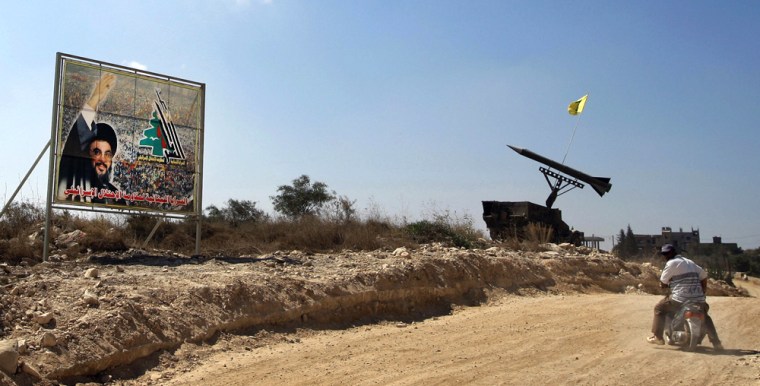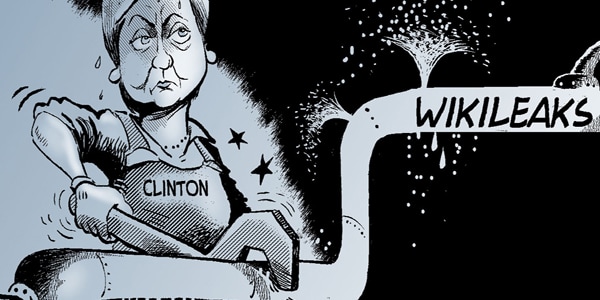Just a week after President Bashar al-Assad of Syria assured a top State Department official that his government was not sending sophisticated weapons to Hezbollah, the Obama administration lodged a confidential protest accusing Syria of doing precisely what it had denied doing.
“In our meetings last week it was stated that Syria is not transferring any ‘new’ missiles to Lebanese Hizballah,” noted a cable sent by Secretary of State Hillary Rodham Clinton in February, using an alternative spelling for the militant group. “We are aware, however, of current Syrian efforts to supply Hizballah with ballistic missiles. I must stress that this activity is of deep concern to my government, and we strongly caution you against such a serious escalation.”
A senior Syrian Foreign Ministry official, a cable from the American Embassy in Damascus reported, flatly denied the allegation. But nine months later, administration officials assert, the flow of arms had continued to Hezbollah. According to a Pentagon official, Hezbollah’s arsenal now includes up to 50,000 rockets and missiles, including some 40 to 50 Fatah-110 missiles capable of reaching Tel Aviv and most of Israel, and 10 Scud-D missiles. The newly fortified Hezbollah has raised fears that any future conflict with Israel could erupt into a full-scale regional war.
Confronting foreign governments
The Syrian episode offers a glimpse of the United States’ efforts to prevent buildups of arms — including Scud missiles, Soviet-era tanks and antiaircraft weapons — in some of the world’s tensest regions. Wielding surveillance photos and sales contracts, American diplomats have confronted foreign governments about shadowy front companies, secretive banks and shippers around the globe, according to secret State Department cables obtained by WikiLeaks and made available to several news organizations.
American officials have tried to block a Serbian black marketer from selling sniper rifles to Yemen. They have sought to disrupt the sale of Chinese missile technology to Pakistan, the cables show, and questioned Indian officials about chemical industry exports that could be used to make poison gas.
But while American officials can claim some successes — Russia appears to have deferred delivery of the S-300 air defense system to Iran — the diplomats’ dispatches underscore how often their efforts have been frustrated in trying to choke off trade by Syria and others, including Iran and North Korea.
The United States is the world’s largest arms supplier, and with Russia, dominates trade in the developing world. Its role as a purveyor of weapons to certain allies — including Israel, Saudi Arabia and other Persian Gulf states — has drawn criticism that it has fueled an arms race. But it has also taken on a leading role as traffic cop in trying to halt deliveries of advanced weapons and other arms to militants and adversaries.
According to the cables, American diplomats have repeatedly expressed concern that huge cargo planes operated by Badr Airlines of Sudan were flying weapons from Tehran to Khartoum, Sudan, where they were shipped to Hamas, the militant group in Gaza.
Sudan insisted that the cargo was farm equipment, but the United States asked countries in the region to deny overflight rights to the airlines. Jordan and several other countries agreed, but Yemen declined, a February 2009 cable reported.
Egypt: Iran supporting Hamas
Egyptian officials, who view Iran with deep wariness, privately issued a threat. Omar Suleiman, the chief of Egypt’s intelligence service, told Adm. Mike Mullen, the chairman of the Joint Chiefs of Staff, that Iran not only was providing $25 million a month to support Hamas but also was linked to a Hezbollah cell trying to smuggle arms from Gaza into Egypt, according to an April 2009 cable.
“Egypt had sent the clear message to Iran that if it interferes in Egypt, Egypt will interfere in Iran,” noted the cable, adding that the Egyptian official said his country had trained agents for that purpose.
North Korea has abetted the arms race in the Middle East by providing missile technology to Iran and Syria, which then backed Hamas and Hezbollah, according to American intelligence officials and a cable from Mrs. Clinton. The cables tell something of an international detective story: how North Korea’s arms industry has conducted many of its transactions through the Korea Mining Development Corporation, relied on suppliers of machinery and steel from countries including Switzerland, Japan, China and Taiwan, passed money through Chinese and Hong Kong banks and sold weapons to other countries.
To disrupt the transactions, American officials have prodded and protested. Diplomats raised questions in the spring of 2009, for example, about planned purchases from North Korea of rocket-propelled launchers by Sri Lanka and Scud missile launchers by Yemen, apparently to no avail.
In July 2009, Stuart A. Levey, a senior United States Treasury official, warned a top official of the People’s Bank of China that “Chinese banks have been targeted by North Korea as the main access point into the international financial system,” according to one cable. And in meetings in Hong Kong that month, Mr. Levey complained that a local businessman was helping procure luxury goods for the North Korean leadership. (The Hong Kong bank later suggested that it had shut down the man’s accounts.)
Isolating Syria
It is the arms transactions involving Syria and Hezbollah, however, that appear to be among the Obama administration’s gravest concerns. President Obama came into office pledging to engage with Syria, arguing that the Bush administration’s efforts to isolate Syria had done nothing to wean it from Iran or encourage Middle East peace efforts.
Even before American diplomats began talks with the Assad government, Senator John Kerry, the Massachusetts Democrat who is the chairman of the Senate Foreign Relations Committee, prodded Mr. Assad in a February 2009 meeting in Damascus to make a gesture that he could take back to the Obama administration as “an indicator of Assad’s good will.” Mr. Kerry told Mr. Assad that Mr. Obama intended to withdraw American troops from Iraq “as soon as possible” and also hinted to a senior Syrian official that the Obama administration intended to take a firm line against the establishment of new Israeli settlements on the West Bank.
“It is not our goal for the United States to be humiliated,” Mr. Assad said, referring to Iraq, according to a cable.
In March 2009, a delegation of State Department and National Security Council officials traveled to Damascus for the first discussions, and in the next several months, each side made some modest gestures.
The United States provided information “regarding a potential threat to a Syrian official” through Syria’s Washington ambassador and allowed a senior aide to George J. Mitchell, the American Middle East negotiator, to attend an Syrian holiday event at the Syrian Embassy, a cable reported. Syria, for its part, allowed the Americans to reopen an English-language school and hosted a team of American military officials to discuss how to better regulate the Syria-Iraq border.
Each side, however, wanted the other to take the first major initiative. Syria kept pressing for the lifting of economic sanctions, which had crippled its aviation industry, and the Americans urged Syria to curtail its support for Hezbollah and Hamas.
“The U.S. had publicly recognized its mistakes, e.g. use of torture methods, and would continue to take steps,” Daniel B. Shapiro, a senior official on the National Security Council told the Syrians in the meeting, according to a May 2009 cable. “But others needed to reciprocate to ensure that the opportunity did not pass.”
By the fall, however, officials at the American Embassy in Damascus appeared concerned that military developments were outpacing the incremental diplomacy.
Buildup in Lebanon
“Syria’s determined support of Hizballah’s military build-up, particularly the steady supply of longer-range rockets and the introduction of guided missiles could change the military balance and produce a scenario significantly more destructive than the July-August 2006 war,” said a November 2009 cable from the American chargé d’affaires in Damascus.
According to cables, Syrian leaders appeared to believe that the weapons shipments increased their political leverage with the Israelis. But they made Lebanon even more of a tinderbox and increased the prospect that a future conflict might include Syria.
A major worry was that Syria or Iran had provided Hezbollah with Fatah-110 missiles, with the range to strike Tel Aviv. (A United States government official said last week that the 40 to 50 missiles were viewed as especially threatening because they are highly accurate.) Israeli officials told American officials in November 2009 that if war broke out, they assumed that Hezbollah would try to launch 400 to 600 rockets at day and sustain the attacks for at least 12 months, the cables note.
In February, the White House announced that a new American ambassador would be sent to Syria after a five-year hiatus. The next day, William J. Burns, a State Department under secretary, met with the Syrian leader.
During the session, Mr. Burns repeated American concerns about weapons smuggling to Hezbollah, one dispatch noted. Mr. Assad replied that while he could not be Israel’s policeman, no “new” weapons were being sent to Hezbollah.
Soon after the meeting, though, a cable noted that the Americans received intelligence reports that the Syrians were about to provide Hezbollah with Scud-D missiles, which are based on North Korean technology. (Some recent intelligence reports conclude that the group has about 10 such missiles stored in a Syrian warehouse, according to American officials. The Defense Intelligence Agency believes that two have probably been moved to Lebanon, according to the officials, speaking on the condition of anonymity.) The United States officials also worried about Hezbollah’s vow to avenge the death of Imad Mughniyah, a senior fighter killed in a 2008 car bombing the militant group said was the work of the Israelis.
In a classified cable in February, Secretary Clinton directed the embassy to deliver a warning to Faisal al-Miqdad, the deputy foreign minister. “I know you are a strategic thinker, which is why I want to underscore for you that, from our perspective, your operational support for Hizballah is a strategic miscalculation that is damaging your long-term national interests.”
The Syrian official’s response was dismissive, according to an American cable. He denied that any weapons had been sent, argued that Hezbollah would not take military action if not provoked and expressed surprise at the stern American protest. The complaint, he said, “shows the U.S. has not come to a mature position (that would enable it) to differentiate between its own interests and Israel’s.”
Michael R. Gordon reported from Washington, and Andrew W. Lehren from New York.
This article, "," originally appeared in The New York Times.

